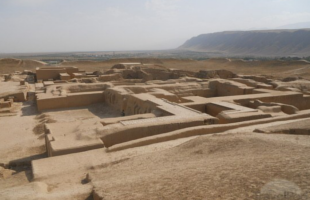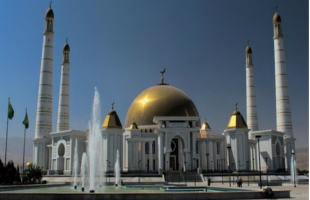Find all the best Museums and Heritage sites now with us….
 The Museum of Fine Arts is an arts museum in Ashgabat, Turkmenistan. It was founded in 1927 by Russian sculptor A.A Karelin and in 1939 it attained the status of the Museum of Fine Arts. The museum has more than 6,000 works in its collection, including paintings, sculptures, and graphic works by Turkmen, Russian and foreign artists. The museum features artwork by such artists as Durdy Bayramov, Husein Huseinov, Amangeldy Hydyr, I. Ilisl, Izzat Klychev, S. Babicov and a notable collection of European paintings including Italian, Dutch, Flemish, German and English. |
 The Ashgabat National Museum of History is a history museum in Ashgabat, the capital city of Turkmenistan. It contains over 500,000 exhibits particularly archaeological and ethnographical finds throughout the country including rare works of ancient art, paintings, drawings, sculptures, carpets, rugs, fabrics and clothing; household utensils, musical instruments, weapons, jewelry, medals, historical documents, horn-shaped vessels made of ivory, statuettes of Parthian goddesses and colourful Buddhist vases. It also contains a significant number of fossils and rare geological finds. |
|
 Nisa or Parthaunisa was an ancient city, located near modern-day Bagir village, 18 km southwest of Ashgabat, Turkmenistan. Nisa is described by some as the first seat of central government of the Parthians. It is traditionally assumed to be founded by Arsaces I (reigned c. 250 BC–211 BC), and was reputedly the royal necropolis of the Parthian kings, although it has not been established that the fortress at Nisa was either a royal residence or a mausoleum. |
 Turkmenbashi Ruhy Mosque or Gypjak Mosque is a mosque in the village of Gypjak about 7 kilometres west of the centre of Ashgabat, Turkmenistan on the M37 highway. The mosque, constructed by the French company Bouygues, was built in the home town of President Saparmurat Niyazov. It opened on October 22, 2004 and was built by Niyazov with a mausoleum in preparation for his death. Niyazov died two years later, and was buried in the mausoleum… |
 Ertuğrul Gazi Mosque or Ärtogrul Gazy Mosque is a mosque in Ashgabat, Turkmenistan. It honors Ertuğrul, the father of Osman I, the founder of the Ottoman Empire. It is a prominent landmark in Ashgabat with its four minarets and central dome and has a lavish interior decoration with fine stained glass windows. The mosque was inaugurated in 1998 and this white marbled building is reminiscent of the Blue Mosque of Istanbul. |
 The “Independence Monument” is a monument located in Ashgabat, Turkmenistan. The design of this building was inspired by traditional Turkmen tents and the traditional headgear worn by Turkmen girls. Elements of the building commemorate the independence date of Turkmenistan, 27 October 1991. These elements include a 91-meter reinforced concrete tower with a 27-metre high golden gilt steel construction on top of the tower, along with an observation terrace with a diameter of 10 metres. |
 The Turkmen Carpet Museum or the National Carpet Museum is a national museum, situated on 5 Gorogly Street in Ashgabat, Turkmenistan. It opened on 24 October 1994. It has the largest collection of Turkmen carpets of any museum. It has a rich collection of Turkmen carpets from the medieval through to the 20th century, including over 1000 carpets from the 18th and 19th centuries. Aside from its extensive collection of antique carpets, it has many carpet articles, chuvals, khurjuns, torba etc. On the first floor of the museum are Tekke and Sarik carpets. |










